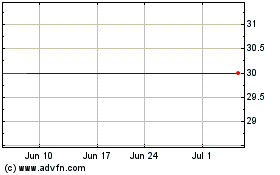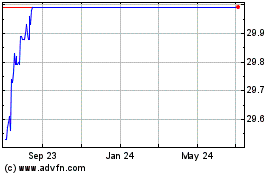By Saumya Vaishampayan,Michael Wursthorn and Steven Russolillo
Hong Kong's stocks fell into a bear market Tuesday, another
casualty of an international selloff driven by trade tensions, a
stronger dollar and worries about the resilience of developing
economies.
It is the latest sign that stocks around the world are feeling
the pressure of the trade fight, exposing the global market's
fragility to the sparring between the U.S. and major trading
partners in Europe and Asia.
To date, major U.S. indexes have mostly stood their ground,
hitting new highs late last month, amid strong economic data and
corporate earnings. The S&P 500 and the Dow Jones Industrial
Average both rose 0.4% Tuesday, while the Nasdaq Composite added
0.6%.
But resurgent trade tensions have knocked the S&P down 0.5%
so far this month, putting it on pace for its first monthly loss
since March.
And shares of several big American conglomerates, including
heavy-equipment maker Caterpillar Inc., car maker General Motors
Co. and aluminum-products maker Arconic Inc., have tumbled more
than 20% from their recent highs, meeting the common definition of
a bear market.
Hong Kong's Hang Seng Index reached the same milestone Tuesday,
following China's benchmark Shanghai Composite in June and MSCI's
flagship emerging-markets index last week. Investors have been
feeling pain particularly in Turkey and Argentina as indexes in
those emerging markets have struggled against the rising
dollar.
The overseas selloff deepened Tuesday after reports that China
plans to ask the World Trade Organization for permission to impose
sanctions on the U.S., which just a week earlier said an additional
$267 billion in tariffs on Chinese goods were ready to go. Trade
negotiations between the European Union and U.S. haven't fared much
better after officials failed to reach a breakthrough Monday,
pushing off the possibility of a deal to the end of September, when
trade officials said they would meet again.
"The president is gearing up to use more hawkish rhetoric on
trade, escalating the potential for a trade war and rising
uncertainty and concern among investors," said David Page, senior
economist at AXA Investment Managers. "The markets are worried
about retaliation and investors are going to have to navigate that
over the next couple of months."
Fears of a trade war that had seemed remote and distant earlier
this year are more pronounced, say investors who worry that the
additional levies on a variety of items -- from agricultural goods
to electronic parts -- will eat into companies' profit margins and
consumers' wallets. And those concerns have sapped some of the
positive momentum U.S. stocks enjoyed after reporting
second-quarter earnings, which saw their biggest year-over-year
gain in six years, according to the Commerce Department.
The turbulence is also expected to further hamper shares of the
big U.S. manufacturers that have tumbled this year. Caterpillar,
which is a component of the Dow industrials, slumped 23% from its
January high to its low last month and remains off 17%. Both
Arconic and metals-mining company Freeport-McMoRan Inc. are down
more than 30% from their highs at the beginning of the year through
their recent lows. And car makers GM and Ford Motor Co. are down
nearly 30% from their previous highs.
Nearly 180 companies in the S&P 500 mentioned "tariff" at
least once during their latest earnings calls, underscoring the
greater focus on trade. Ford, for example, said sales in China
plunged 26% in the first half, compared with the same period a year
earlier, as trade tensions forced the car maker to endure its
poorest first-half showing in China since 2012.
Analysts say an escalation in tariffs could cost a U.S.-based
investor somewhere between 8% and 17% of their global portfolio's
value, according to FactSet.
"The tone of the markets today has become somewhat anxious," Tom
Stringfellow, president and chief investment officer of Frost
Investment Advisors, wrote in a recent note. "While the domestic
equity markets are higher on a year-to-date basis, they've not
responded to the level we might have expected, given recent
corporate earnings growth."
The declines have been broader in Asia, where the Hang Seng,
which has a market capitalization of $2.1 trillion, dropped 0.7%
Tuesday. Slightly more than half of the index's 50 components are
mainland Chinese companies -- including Tencent Holdings Ltd.,
China Construction Bank Corp. and China Mobile Ltd. -- making the
index highly sensitive to concerns about the health of the world's
second-largest economy.
Tencent, the most valuable company listed in Hong Kong, has
particularly weighed on the index. It has lost more than $200
billion in market value from a peak in January, a sum larger than
the market value of all but 23 companies in the S&P 500.
Back in the U.S., investors credit the booming economy for the
U.S. stock market's strength relative to the rest of the world.
Profits among American companies continue to soar and have helped
to keep the broad S&P 500 index from tumbling much lower,
investors said, and expectations continue to be robust heading into
the third-quarter reporting period. FactSet estimates S&P 500
companies will increase third-quarter profits 20% from a year
earlier, which would be the third highest growth rate since the
third quarter of 2010.
U.S. payrolls expanded a 95th consecutive month in August, while
the unemployment rate stayed at 3.9% for a second month in a row.
Wages are showing signs of moving higher after the Labor Department
reported 2.9% growth from a year earlier. And the ISM survey of
manufacturing is at its best since 2004.
"We remain bearly bullish," said Ed Keon, chief investment
strategist at QMA, the $128 billion quantitative equity arm of PGIM
Inc. "It's hard to underweight stocks in our global multiasset
portfolios with earnings growth that is likely to be almost 25% in
2018 and GDP growth north of 3%."
Write to Michael Wursthorn at Michael.Wursthorn@wsj.com and
Steven Russolillo at steven.russolillo@wsj.com
(END) Dow Jones Newswires
September 11, 2018 18:54 ET (22:54 GMT)
Copyright (c) 2018 Dow Jones & Company, Inc.
Arconic (NYSE:ARNC)
Historical Stock Chart
From Mar 2024 to Apr 2024

Arconic (NYSE:ARNC)
Historical Stock Chart
From Apr 2023 to Apr 2024
